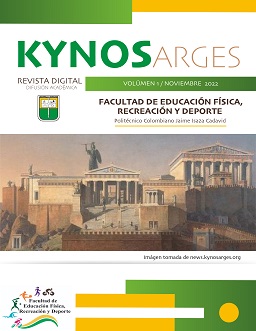Dios Curriculista- un análisis documental sobre la idea de Cuerpo, Formación y Hombre, en los currículos de Educación Física en básica primaria en I. E. Religiosas.
Palabras clave:
cuerpo, currículo, hombre, formaciónResumen
Los currículos de Educación Física a lo largo de la historia se han visto acompañados de diferentes posturas políticas, económicas, sociales y religiosas, esto ha llevado a que, en la actualidad, y a partir de los exámenes de evaluación realizados anualmente (como las pruebas ICFES) las instituciones educativas (I.E) de carácter privado y religioso sean las que postulen el tipo de hombre, cuerpo y formación que ellos consideran como mejores. Del mismo modo, estas instituciones educativas a través de sus currículos muestran sus diferentes posturas ideológicas, en especial sobre el cuerpo. No obstante, el objetivo principal de esta investigación es interpretar la idea de cuerpo que hay en los currículos de las 45 mejores instituciones de la ciudad de Medellín (Según Sapiens Research), esto se hará mediante el marco conceptual de Pedraza, Z. (2010), Bollnow, O. F. (2005) y Da Silva, T. T. (2001). La metodología tiene un enfoque mixto, acompañada de un análisis de contenido como método y una sistematización documental como técnica. Un hallazgo importante es que el cuerpo para estas instituciones educativas es mono - facético, es decir, se comprende desde el currículo como una herramienta, templo o máquina, además, sigue existiendo la distinción entre sexos a la hora de desarrollar el currículo del área de Educación Física.
Métricas de artículo
Resumen: 242 PDF: 113Citas
Avendaño, F. (1988). Ser católico: principio de inserción y compromiso histórico. Revista Praxis, (22-21), 9-21.
Barriga, Á. D. (1997). Didáctica y currículum. Paidós.
Bollnow, O. F. (2005). Principios metódicos de la antropología pedagógica. Revista Educación y Pedagogía, 17(42), 77-80.
Da Silva, T. T. (2001). Dr. Nietzsche, curriculista, con aportes del profesor Deleuze: una mirada post-estructuralista de la teoría del currículum. Pensamiento Educativo, Revista de Investigación Latinoamericana (PEL), 29(2), 15-36. Dogliotti, P. (2012). Cuerpo y currículum: discursividades en torno a la formación de docentes de educación física en Uruguay (1874-1948).
de Bogotá, CDC (1994). Ley 115 de 1994.
Duverger, M. (1962). Métodos de investigación en las relaciones sociales. Rialp.
Enríquez, M. F. C. El análisis de la realidad social: Métodos y técnicas de investigación. García M., Alvira, F., Alonso, L. y Escobar, M. (comps.). Alianza, 2015. Revista Española de Sociología, 25(3).
Grundy, S. (1998). Producto o praxis del curriculum. Ediciones Morata.
Hostil O.R. (1969) Content analysis for the social sciences and humanities. Addison
Ortega, A. O. (2018). Enfoques de investigación. https://www. researchgate. net/profile/Alfredo_Otero_Ortega/publication/326905435_ENFOQUES_DE_INVESTIGACION_TABLA_DE_CONTENIDO_Contenido/links/5b6b7f9992851ca650526dfd/ENFOQUES-DE-INVESTIGACION-TABLA-DECONTENIDO-Contenido. pdf el, 14.
Pedraza, Z. (2010). Saber, cuerpo y escuela: el uso de los sentidos y la educación somática. Calle14: revista de investigación en el campo del arte, 4(5), 44-56.
Sánchez, M. L. Z. (2002). Corrientes y tendencias de la Educación Física (Vol. 571). Inde.
Stone, P.J. Dunphy D.C, Smith M.S. Ogilvie D. M. (Ed) (1966), The general inquirie
Troeltsch, E. (2021). El protestantismo y el mundo moderno. Fondo de Cultura Económica.
Descargas
Publicado
Número
Sección
Licencia
Derechos de autor 2022 Andrés Mora Pérez, Camila Andrea Jiménez Arteaga, María Cristina García, Andrés Felipe Correa Castaño

Esta obra está bajo una licencia internacional Creative Commons Atribución-NoComercial-CompartirIgual 4.0.


